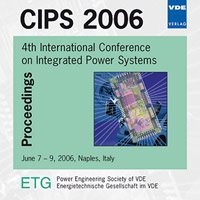Analyzing the Theoretical Limits of Forced Air-Cooling by Employing Advanced Composite Materials with Thermal Conductivities > 400W/mK
Konferenz: CIPS 2006 - 4th International Conference on Integrated Power Systems
07.06.2006 - 09.06.2006 in Naples, Italy
Tagungsband: CIPS 2006
Seiten: 6Sprache: EnglischTyp: PDF
Persönliche VDE-Mitglieder erhalten auf diesen Artikel 10% Rabatt
Autoren:
Drofenik, Uwe; Kolar, Johann W. (Power Electronic Systems Laboratory, ETH Zurich, ETH-Zentrum / ETL H13, CH-8092 Zurich, Switzerland)
Inhalt:
The cooling system takes a significant portion of the total mass and/or volume of a power electronic system. In order to design a converter with high power density, it is necessary to minimize the converter’s cooling system volume for a given maximum tolerable thermal resistance. This paper theoretically investigates, if the cooling system volume can be significantly reduced by employing new advanced composite materials like isotropic Aluminum/Diamond Composites or anisotropic Highly Orientated Pyrolytic Graphite (HOPG). Another strategy to improve the power density of the cooling system is to increase the rotating speed and/or the diameter of the fan, which is limited by increasing power consumption of the fan. Fan scaling laws are employed in order to describe volume and thermal resistance of an optimized cooling system (fan plus heat sink), resulting in a single compact equation dependent on just two design parameters. Based on this equation, a deep insight into different design strategies and their general potentials is possible. The theory of the design process is verified experimentally for cooling a 10kW-converter.


